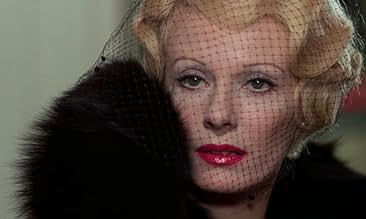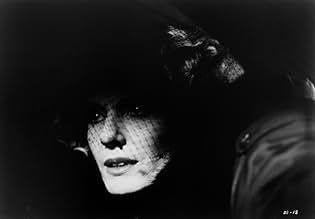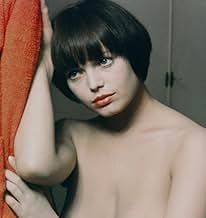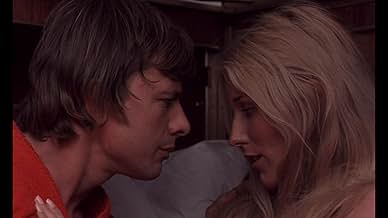NOTE IMDb
6,5/10
7,5 k
MA NOTE
Un couple de jeunes mariés traverse une station balnéaire. Leurs chemins se croisent avec une comtesse mystérieuse et d'une beauté saisissante et son assistante.Un couple de jeunes mariés traverse une station balnéaire. Leurs chemins se croisent avec une comtesse mystérieuse et d'une beauté saisissante et son assistante.Un couple de jeunes mariés traverse une station balnéaire. Leurs chemins se croisent avec une comtesse mystérieuse et d'une beauté saisissante et son assistante.
- Réalisation
- Scénario
- Casting principal
Avis à la une
Beware as you go into this, it may sound like Hammer but it's nothing like it. It's a chic, stylish vampire film dripping with the most wanton aestheticism. The whole thing exudes the scent of an absinthe dream, the contours of a flowing red dress.
Superficially it is about a couple of newly-weds - but who, as the film opens with them having sex in a train cabin, openly declare that they don't love each other - who find themselves stranded in Ostande and move in to a strangely empty hotel for a few days. A countess Bathory arrives there with her female companion, there's also the baffled concierge who tries to stay out of passion's way.
I say superficially because the dynamics between the couple is what at first sight seems to be driving the story. The woman is desperate to break out from the limbo of anonymous sex and be introduced, thus be legitimized as a wife and woman, to the man's mother, an aristocrat back in England. The man, on the other hand, is content to derail those expectations and savour the erotic dream he has concocted to inhabit.
But of course we come to understand that the narrative is powered from outside. The countess courts both, seducing in the emotional space between them. She personifies that wanton aestheticism right down to her body language. It is important to note that she is played by the actress who starred in Marienbad for Resnais, which this film alludes to; in the mysterious hotel setting with its expansive balustrades, in the twilight wanderings, in the sense of time revoked and sensations amplified.
She is the architect of all this, building around these people the desires that will yield them to her. So it is the man's semi-conscious world of secret pleasures, but it's she who is slowly, slyly perverting them. She does this with the malevolent purity of a femme fatale.
It does not matter that she is Bathory, or that blood is eventually savored from wrists, this is merely the desire made visible in a way that would appeal to a niche audience. So even though Jess Franco borrowed the velvety sunsets and decadent air from this for Vampyros Lesbos, this operates deeper. It matters for example that she seduces the man into a new obsession with violence, the destructive flipside of eros. It further pries the woman apart from him.
Gradually what was a matter of taking pleasure from flesh is spun into something else entirely; again involving flesh but now literally draining from his.
It ends with a stunning sequence across countryside roads; a lot of the imagery recalls L'Herbier - who also inspired Resnais - but here more pertinently. The soul has been so withered away from inside, so consumed from the fever of passion, that mere sunlight sends it reeling. Of course we can explain away by falling back to our knowledge of vampire lore, but we'd be missing on the finer abstractions; how, for example, the femme fatale is magically cast into the circumstances that, as we know from our knowledge of this type of film, would precipitate her demise. Nothing else would do after all.
If we follow the set of reactions from what at first sight appears like an accident, it can be plainly seen how it all flows from her desire to control the narrative.
It's marvelous stuff just the same, the colors, the desolate aura. I just want to urge you to see as more than just an 'artsy vampire flick'. Save that for Jean Rollin.
Superficially it is about a couple of newly-weds - but who, as the film opens with them having sex in a train cabin, openly declare that they don't love each other - who find themselves stranded in Ostande and move in to a strangely empty hotel for a few days. A countess Bathory arrives there with her female companion, there's also the baffled concierge who tries to stay out of passion's way.
I say superficially because the dynamics between the couple is what at first sight seems to be driving the story. The woman is desperate to break out from the limbo of anonymous sex and be introduced, thus be legitimized as a wife and woman, to the man's mother, an aristocrat back in England. The man, on the other hand, is content to derail those expectations and savour the erotic dream he has concocted to inhabit.
But of course we come to understand that the narrative is powered from outside. The countess courts both, seducing in the emotional space between them. She personifies that wanton aestheticism right down to her body language. It is important to note that she is played by the actress who starred in Marienbad for Resnais, which this film alludes to; in the mysterious hotel setting with its expansive balustrades, in the twilight wanderings, in the sense of time revoked and sensations amplified.
She is the architect of all this, building around these people the desires that will yield them to her. So it is the man's semi-conscious world of secret pleasures, but it's she who is slowly, slyly perverting them. She does this with the malevolent purity of a femme fatale.
It does not matter that she is Bathory, or that blood is eventually savored from wrists, this is merely the desire made visible in a way that would appeal to a niche audience. So even though Jess Franco borrowed the velvety sunsets and decadent air from this for Vampyros Lesbos, this operates deeper. It matters for example that she seduces the man into a new obsession with violence, the destructive flipside of eros. It further pries the woman apart from him.
Gradually what was a matter of taking pleasure from flesh is spun into something else entirely; again involving flesh but now literally draining from his.
It ends with a stunning sequence across countryside roads; a lot of the imagery recalls L'Herbier - who also inspired Resnais - but here more pertinently. The soul has been so withered away from inside, so consumed from the fever of passion, that mere sunlight sends it reeling. Of course we can explain away by falling back to our knowledge of vampire lore, but we'd be missing on the finer abstractions; how, for example, the femme fatale is magically cast into the circumstances that, as we know from our knowledge of this type of film, would precipitate her demise. Nothing else would do after all.
If we follow the set of reactions from what at first sight appears like an accident, it can be plainly seen how it all flows from her desire to control the narrative.
It's marvelous stuff just the same, the colors, the desolate aura. I just want to urge you to see as more than just an 'artsy vampire flick'. Save that for Jean Rollin.
Finally it became available, the director's cut of this 40 year old vampire flick. The weirdness is that it doesn't contain real vampires like you know them. You never see any fangs but it's the atmosphere that keep you attracted to the teevee. The other part that is funny for me is that all the places shown I have seen them, easily to explain, I grow up in Ostend in the seventies. But what an excellent flick this is, even without the gore and almost without th red stuff. There is a lot of nudity but it never becomes gratuitous. It is also strange that a Flemish director (Harry Kumel) was able to get big names, Delphine Seyrig was an icon at that time and even the others were well known then. The quality available on the Blue Underground DVD is excellent, even the sound is great, no hiss or whatsoever. It is a beauty to see and remembering that it was made without a big budget. It is indeed as stated on the sleeve erotic and unusual.
The follow-up to Kümel's "Malpertuis" (from Jean Ray's book),"Les Lèvres Rouges " has got a much simpler screenplay and ,with one exception no great stars (no Orson Welles,Michel Bouquet,Susan Hampshire ,Jean-Pierre Cassel.....)....
One star ,but what a star!Delphine Seyrig was one of the greatest stars France had ever had.She mesmerized her audience as no actress of her generation could;her death was a major loss for the European cinema.She could play the fairy godmother of "Peau D'Ane ",the dumb bourgeois lady of "Le Charme Discret De La Bourgeoisie" or the legendary bloody countess -many historians do not believe in those blood baths -with the same aplomb;three parts so different and the same woman with the same suave voice -you MUST hear her speak,a dubbed version would be a disaster;so make sure you get a DVD with subtitles.
I have always thought Belgian directors were very good at creating a supernatural atmosphere without using a ton of special effects;like Delvaux in "Un Soir Un Train" ,Kümel makes the simple picture of a train which comes to a standstill.The baroque hotel will remind some users of "L'Année Dernière A Marienbad" ,Seyrig's debut in France.
It's to state the obvious to write that Seyrig steals every scene she is in and fortunately she's featured in many scenes ;the three other leads seem bland by comparison and it takes all the talent of the director to pull them off.
"Les Levres Rouges" gave a renewed life to the vampire movie ,like Polanski's "the fearless vampire killers" did in the precedent decade .A strong lesbian interest in this movie too:Seyrig was so hot she could appeal to both men and women.
One star ,but what a star!Delphine Seyrig was one of the greatest stars France had ever had.She mesmerized her audience as no actress of her generation could;her death was a major loss for the European cinema.She could play the fairy godmother of "Peau D'Ane ",the dumb bourgeois lady of "Le Charme Discret De La Bourgeoisie" or the legendary bloody countess -many historians do not believe in those blood baths -with the same aplomb;three parts so different and the same woman with the same suave voice -you MUST hear her speak,a dubbed version would be a disaster;so make sure you get a DVD with subtitles.
I have always thought Belgian directors were very good at creating a supernatural atmosphere without using a ton of special effects;like Delvaux in "Un Soir Un Train" ,Kümel makes the simple picture of a train which comes to a standstill.The baroque hotel will remind some users of "L'Année Dernière A Marienbad" ,Seyrig's debut in France.
It's to state the obvious to write that Seyrig steals every scene she is in and fortunately she's featured in many scenes ;the three other leads seem bland by comparison and it takes all the talent of the director to pull them off.
"Les Levres Rouges" gave a renewed life to the vampire movie ,like Polanski's "the fearless vampire killers" did in the precedent decade .A strong lesbian interest in this movie too:Seyrig was so hot she could appeal to both men and women.
I first saw this movie when I was 12 and it had a huge impact on my early artistic endeavors as a young man. I've seen it periodically over the years and can see what intrigued me about it so much. It's part Ingmar Bergman film and part bad vampire movie. There are some beautifully filmed scenes along with some awful dialogue. The brilliant Delphine Seyrig is superbly creepy. The other performances are only mediocre. The music is appropriately over the top; sometimes sinister, sometimes goofy- seventies movie. The new director's cut contains more sex and nudity, probably to avoid getting an x-rating at the time of release. It's definitely worth checking out if you've never seen it.
A contained, haunting tale of vampirism, with ties to the infamous Elizabeth Bathory, this film drips with artistic merit. From the picturesque shots to the red fades to the stinger notes, it's easy to appreciate this production. The delicate, deliberate pace may turn off some viewers but the dream-like atmosphere easily held my attention, not to mention the three beautiful female leads. The bizarre ending (before the epilogue) was unexpected and indeed provided a wonderfully macabre and memorable image. Daughters of Darkness succeeds at what Vampyros Lesbos attempted to be. Just make sure to watch the full version.
Le saviez-vous
- AnecdotesDuring filming, director Harry Kümel hit actress Danielle Ouimet during a dispute. Actor John Karlen was so infuriated by this behavior that he punched Kumel in the face. The atmosphere on the set was understandably tense afterwards.
- GaffesWhen Ilona is lying on the bathroom floor, bikini marks are visible. Vampires are not supposed to have tan lines.
- Citations
Countess Bathory: Love is stronger than death... even than life.
- Versions alternativesThe original U.S. theatrical release was cut by approximately 12 minutes to obtain an R-rating, and features a slightly different opening credits sequence in which Lainie Cooke (not Delphine Seyrig as sometimes rumored) sings over the main theme of the film. This sequence features a stylized title logo (the same as that on the U.S. posters), while the rest of the credits use a font that is more formal and less bold compared to the original version. After being released on Canadian and American VHS (where it was retitled "Children of the Night"), the U.S. version was eventually replaced in circulation by the uncut version in the 1990s, although its title sequence is presented among the special features of Blue Underground's 2020 4K Blu-ray release of the film.
- ConnexionsEdited into Rob Zombie: Living Dead Girl (1999)
- Bandes originalesDaughters of Darkness
Written and Performed by François de Roubaix
Sung by Lainie Cooke
Lyrics by Terence Stockdale
Meilleurs choix
Connectez-vous pour évaluer et suivre la liste de favoris afin de recevoir des recommandations personnalisées
- How long is Daughters of Darkness?Alimenté par Alexa
Détails
- Date de sortie
- Pays d’origine
- Langues
- Aussi connu sous le nom de
- Daughters of Darkness
- Lieux de tournage
- Sociétés de production
- Voir plus de crédits d'entreprise sur IMDbPro
Box-office
- Budget
- 750 000 $US (estimé)
- Montant brut mondial
- 1 070 $US
- Durée1 heure 27 minutes
- Mixage
- Rapport de forme
- 1.66 : 1
Contribuer à cette page
Suggérer une modification ou ajouter du contenu manquant

Lacune principale
By what name was Les lèvres rouges (1971) officially released in India in English?
Répondre


























